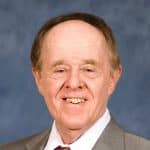All the world is a Filter Richard V. Snyder
Biography
President of RS Microwave (Butler, NJ, USA, founded 1981), author of 124 papers, three book chapters and holds 26 patents. Interests: E-M simulation, network synthesis, dielectric and suspended resonators, high power notch and bandpass filters and active filters. BS, MS and PhD degrees from Loyola-Marymount, USC and Polytechnic Institute of New York University. Served the IEEE North Jersey Section as Chairman,14 year Chair of the MTT-AP chapter. Chaired the IEEE North Jersey EDS and CAS chapters for 10 years. He twice received the Region 1 award. January 1997: named a Fellow of the IEEE and is now a Life Fellow. January 2000: received the IEEE Millennium Medal. He was General Chairman for IMS2003, in Philadelphia, and was Emeritus Chair for IMS2018 also in Philadelphia. He was elected to ADCOM in 2004. Within the ADCOM, he served as Chair of the TCC and Liaison to the EuMA. He served as an MTT-S Distinguished Lecturer: from 2007-2010, continuing as a member of the Speakers Bureau. Associate Editor for the IEEE Transactions on Microwave Theory and Techniques, responsible for most of the filter papers submitted. He is currently a member of the American Physical Society, the AAAS and the New York Academy of Science. He was the MTT-S President for 2011. He is currently a reviewer for IEEE-MTT, Circuits and Systems Transactions and EMC publications. Teaches and advises at the New Jersey Institute of Technology, and is a Visiting Professor at the University of Leeds, in the U.K. He served 7 years as Chair of MTT-8 and continues in MTT-8/TPC work for many conferences, including IMS, EuMW, Asia-Pacific Microwave Conference and others. He is currently Chair of the IMSEC and N&A committees, for the ADCOM. He is the organizer of the annual IWS conference in China.
Presentations
Present and Future Filter Design Philosophy: Paradigm Shift in Progress
The design of passive filter networks has traditionally been a process in which approximations are made to a desired transfer function using reactive and resistive elements exhibiting the same frequency-dependent functional form. Over the years, a variety of synthesis techniques have been developed that allow for extracting sets of such elements from the transmission and reflection functions associated with approximating the desired transfer function when terminated with a specified source and load impedance. We know that physically it is not difficult to combine lumped, distributed and evanescent elements in the same network. Optimization allows for insertion of elements with different frequency dependencies, but exact synthesis is generally not possible. This presentation will address present approaches and will provide insight into future design approaches.
Computing and Enhancing Power Handling in Bandstop Filters
Notch filters are increasingly important components in high power communication systems. Cosite interference analog suppression techniques depend heavily on eliminating emission of spurious high power signals at the source, or suppressing such signals prior to a receiver. Understanding and enhancing the ability of notch filters to survive exposure to high RF power is the subject of this presentation. The power handling capability of bandpass and lowpass filters has been studied and much published material is readily available. However, bandstop and highpass filters have not been studied as thoroughly (or public results are not as easy to find). In this presentation, we will present the basic computational basis for determining power handling and suggest methods for increasing the breakdown and/or heat-related failure thresholds.
